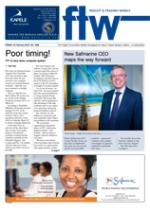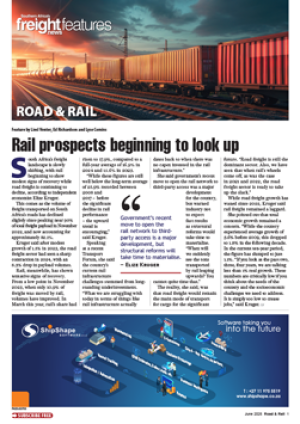The shipping industry lost in
the region of $20 billion in
2009, according to Drewry
Consultants, and Safmarine
did not escape unscathed.
But there’s a plan in place
and it’s already bearing fruit,
says recently appointed CEO
Tomas Dyrbye.
The line’s recovery focuses
on three core areas – costs,
revenue and structures.
“In terms of costs, we are
keeping a tight rein on any
kind of spending and looking
carefully at head count,”
Dyrbye told FTW.
“While there have been
some redundancies and
more can’t be ruled out for
2010, it’s a small number
and Safmarine has done well
compared with the rest of
the industry.
“We are fortunate with
regard to vessel costs since
most are jointly shared with
Maersk Line, giving us the
benefits of scale on which we
constantly work to produce at
a lower cost than if we were
standalone.”
While Safmarine carried
marginally higher cargo
volumes last year, revenue
was severely depressed
and freight rate recovery is
therefore a priority.
“Although we have
achieved a lot, freight rates
are still not at the levels they
were at the peak of 2008. We
are maybe halfway back up
from where we came.”
Responding to shipper
allegations that lines have
cut capacity by withdrawing
ships in order to increase
rates, Dyrbye pointed out
that it was a logical course
of action.
“When there is a drop in
volumes, it’s logical for lines
to withdraw capacity.”
In addition to taking
vessels out of service, slow
steaming also saved a lot of
money last year, he added.
The bottom line is to
create a leaner organisation
but to improve customer
service.
A tall order, but with
the right structures in
place it can be achieved,
says Dyrbye, pointing
to Safmarine’s recently
launched pilot scheme to
process all e-commerce
bookings through service
centres in India, Manila
and China.
“Effectively it frees
up local staff, giving
the customer speedier
turnaround because the
service centres deal purely
with e-commerce bookings.”
Globally 75% of bookings
are handled via ecommerce,
according to Dyrbye, who
makes it clear that there
will always be the option
of human interaction if the
client requires it.
There’s no question that
the worst of the crisis is over,
but Dyrbye is realistic – that
recovery will be slow.
He is however confident
that Safmarine has weathered
the worst of the storm and
that the groundwork has
been laid for a return to
profitability as the world
economy stutters back into a
cycle of growth.
Freight rates a key focus as recovery begins
19 Feb 2010 - by Joy Orlek
0 Comments
FTW - 19 Feb 10

19 Feb 2010
19 Feb 2010
Border Beat
25 Jun 2025
17 Jun 2025
